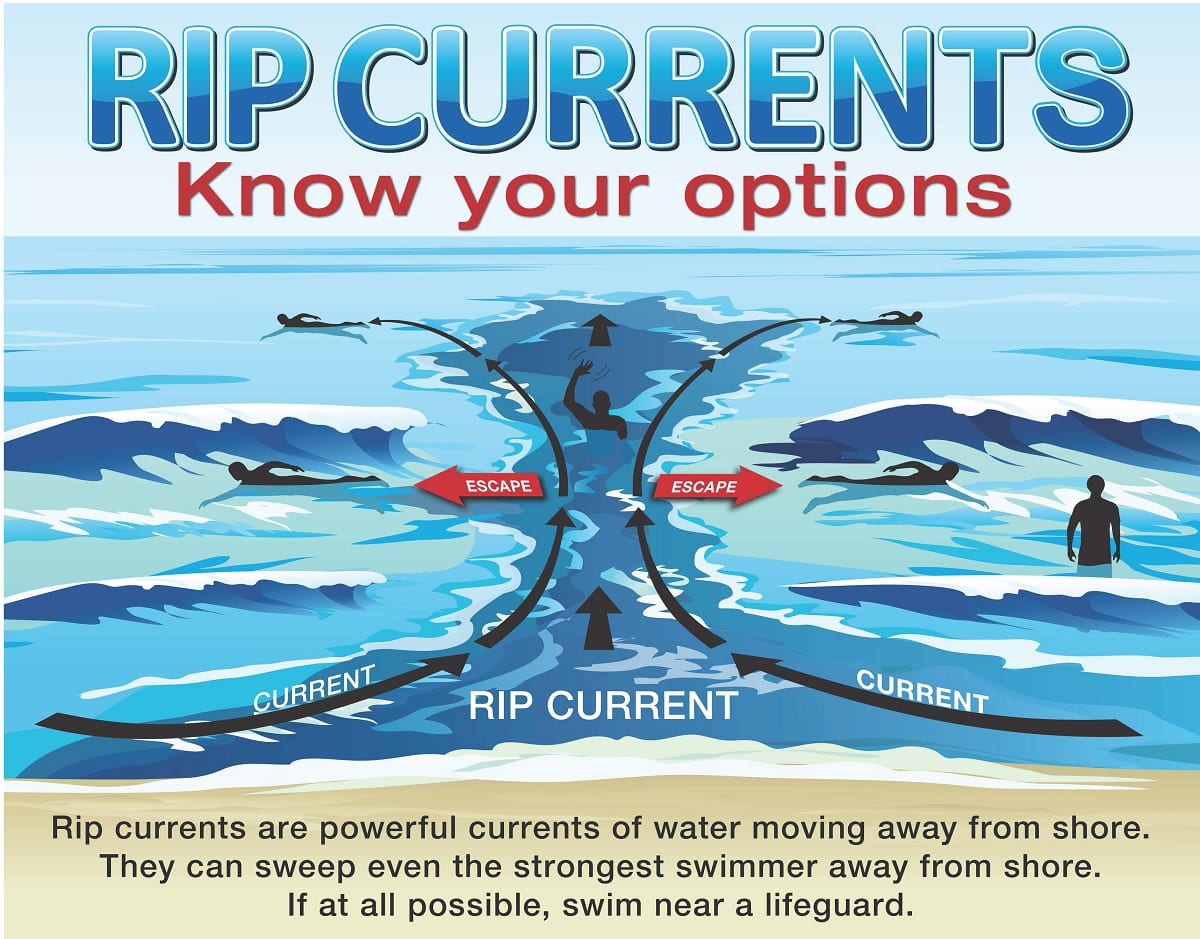Now that summer is here, people across the country and around the world are enjoying beach days. But if you’ve been reading the top headlines over the last few weeks, you’ve likely seen that there have been a disturbing number of drownings due to rip currents.
 Here are just three examples:
Here are just three examples:
3 Alabama tourists die after getting caught in rip current during nighttime swim at Panama City Beach
“A nighttime beach swim took a tragic turn for three men visiting northwest Florida from Alabama this weekend, after they were caught in a rip current and later died, according to the Bay County Sheriff’s Office. The men, all in their 20s, were swimming off the coast of Panama City Beach on Friday when the sheriff’s office received a report of three distressed swimmers shortly after 8 p.m., according to Bay County Sheriff Tommy Ford.” CNN
Couple drowns in rip current while on vacation with their kids in Florida
“A Pennsylvania couple drowned in a rip current while on vacation in Florida with their six children, according to authorities. The parents, 51-year-old Brian Warter and 48-year-old Erica Wishard, were swimming on Hutchinson Island Thursday afternoon when the couple and two of their teenage children were swept out to sea by a rip current, the Martin County Sheriff’s Office said.” ABC News
American tourist, 45, and girlfriend, 48, drown on beach in Thailand
“James Edmond Newman, 45, from New York, was washed ashore, while Waranya Chanphai, 48, from Surin province, was found floating off Mai Khao Beach in Phuket on Monday morning, according to the Bangkok Post. According to Police Major Ronnapoom Permpoon of the Thachatchai Police Station said cops received a report at 7:07 am, Bangkok Post reported.” Daily Mail
Weather.com just reported that “a woman from St. Louis, Missouri became the seventh person over four days to die in rip currents along Florida beaches. 60-year-old Debbie Szymanski was swimming on the west end of Panama City Beach on Sunday morning when relatives noticed she was in trouble, said the Bay County Sheriff’s Office.”

I took my kids to the beach in L.A. and Nantucket in the past week and there were visible signs of rip currents. In Manhattan Beach, a lifeguard (pictured above) was working hard to get swimmers out of dangerous areas.

In Nantucket, the beach we were visiting didn’t have lifeguards and the water was rough so I wouldn’t let my kids go in the water. I put a life preserver on my four-year-old while she jumped in the tide line and I stood next to her without taking my eyes off of her.
Swimmers have to worry about hazardous conditions like rip currents all over the world. According to Weather.gov, “Typically, [rip currents] form at breaks in sandbars, and also near structures, such as jetties and piers, as well as cliffs that jut into the water. Rip currents are common and can be found on most surf beaches, including the Great Lakes and Gulf of Mexico.”
RELATED: Don’t do this when you’re swimming
FYI: “Rip currents are channelized currents of water flowing away from shore at surf beaches.” What caught my attention was an ABC News 7 piece in which a lifeguard said he’s rescued all kinds of people, including an Olympic water polo player. He said it doesn’t matter if you’re are phenomenal swimmer or how fast you are. Getting caught in a current is like swimming up a river.

How to survive a rip current
Weather.gov offers helpful information to help swimmers survive a rip current. If you ever find yourself in this scary and dangerous situation, here’s what they say to do:
-Relax. Rip currents don’t pull you under.
-A rip current is a natural treadmill that travels an average speed of 1-2 feet per second, but has been measured as fast as 8 feet per second — faster than an Olympic swimmer. Trying to swim against a rip current will only use up your energy; energy you need to survive and escape the rip current.
-Do NOT try to swim directly into to shore. Swim along the shoreline until you escape the current’s pull. When free from the pull of the current, swim at an angle away from the current toward shore.
-If you feel you can’t reach shore, relax, face the shore, and call or wave for help. Remember: If in doubt, don’t go out!
-If at all possible, only swim at beaches with lifeguards.
-If you choose to swim on beaches without a lifeguard, never swim alone. Take a friend and have that person take a cell phone so that person can call 911 for help.
This story was originally published in 2021 but I’ve updated it with current information due to the significant uptick in drownings. It’s imperative that all beachgoers know what to look for and how to escape a rip current.
KEEP READING
–Going on a cruise? Be sure to bring this
–One thing I wish I’d bought before going on a cruise
–A reader suggested this little-known cruise essential I never knew existed and she was spot-on
–Johnny Jet’s top 10 cruise tips
–12 things I learned from traveling to Europe this summer
Want more travel news, tips and deals? Sign up to Johnny Jet’s free newsletter and check out these popular posts: The Travel Gadget Flight Attendants Never Leave Home Without and 12 Ways to Save Money on Baggage Fees. Follow Johnny Jet on MSN, Facebook, Instagram, Pinterest, and YouTube for all of my travel posts.




When in doubt, don’t go out!
Rip currents are the most important surf danger for all beach goers. Rip current speeds are usually 1-2 feet per second. Though, speeds as high as 8 feet per second have been measured. Rip currents can occur at any surf beach with breaking waves, including the Great Lakes.
This is a very valuable tip. At a time of year when people go to the beach for relaxation, they may not be thinking Safety. I’ve been caught in strong currents and they are not fun, but the advice is correct. Stay calm, swim to the side instead of trying to head straight to shore, and you’ll be alright. Don’t be embarrassed to call out for help. Lifeguards may not be aware of all of that day’s currents, and your request for help might prompt them to raise a black flag that saves someone else that day.
I would also add to be careful of hydraulics and eddies when swimming in “blue holes,” those deep pools that form in rivers, especially in the mountains, that can suck you under and never spit you back out. If you don’t know how to swim well, don’t assume that just because it looks like a lazy river that there’s not swirling water below the surface, and also lots of rocks.
And lastly I would add that you should ALWAYS determine the depth of any water you jump or dive into by swimming under and looking for yourself, especially dark water in rivers and ocean pools. Don’t just grab last year’s swing rope and launch yourself in the water without testing it to see if it’s at least 12 feet deep, to keep from breaking your spine. I went to college with someone who will be in a wheelchair for the rest of his life because he dove into shallow water. He was an experienced cliff diver, and knew better, which just goes to show complacency can happen to anyone around water. Think!